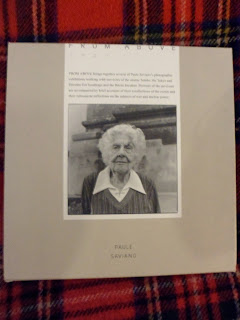Throughout the term in Epigram's Art section we have been asking local people who work in the arts sector to select their favourite book and explain the impact it has had on their life. In favour of democracy, I have decided it is now my turn to do so and would like to introduce From Above, by Paule Saviano.
This is what it looks like sitting on my bed:
Side One (English):
This is what it looks like sitting on my bed:
Side One (English):
And side Two (Japanese):
From Above is ostensibly a photography book. The images tell the stories of survivors of the two atomic bombs dropped on Japan at the end of second world war, along with survivors of the horrific firebombings of Tokyo and Dresden and the Bikini Incident.
Aside from the beautiful black and white photographs, the book itself is a very lovely object. Slid carefully out from its grey record-sleave cover, it is a spaghetti-eater's nightmare. A sea of never ending white, carefully hand-printed on to, it should probably never have come near me as I am renowned for spilling at least three different types of liquid on myself before breakfast has even begun.
But come near me it did, in a special package from Tokyo ('Is there anything more exciting than international mail?' said the girl who spends her life on email). It came near me because I unfortunately attempted to edit and proofread the English translations of the German and Japanese reminiscences given by each of the survivors. 'Unfortunately' because it turned out to be, at times, a bit of a farcical job as each England via New York to Tokyo and back again instruction became increasingly garbled ('Ahh yes, I remember why international communication is not so exciting' she said now). When I look at it now, I see that a few misplaced apostrophes or errant fullstops are really immaterial, especially as the point of the book is the pictures, but I am a perfectionist and, at the time, wanted to throw a brick at whoever wasn't following my specific, anal instructions regarding semi-colons.
The text in this book is like a bad child, peppered with tiny mistakes that I tried to erase and failed. But like a silly child, I still love it and I think that if anyone but myself comes away from reading the both heartbreaking and inspiring stories contained with in only thinking of a few stupid commas, then they will be greater fool and pedant.
I also like the book because it was one of the first times someone had faith in me and entrusted me with a pretty major project. That kind of trust is often hard to find when you are young and taking baby steps into a career. The cycle of not getting jobs because of a lack of experience, but having no experience because noone will give you a tiny break to begin with, seems very dominant in England at the moment, especially in more creative areas. This is a massive shame as it is preventing adept people from using their talents and developing them.
When I first read the stories in the book, a lot of them either made me cry or left me in some kind of suspended disbelief as I couldn't even fathom the level of horror and grief contained within them. Choosing which lines to cut out of a story in which someone is severely injured for the rest of their lives is tricky. Trying to find words to re-phrase a sentence which describes a man returning to find the house, in which his entire family were sheltering in the basements of, completely destroyed is even trickier, perhaps almost impossible. But here this stops mattering, because when the words are inept (and the punctuation even more so) what remains are the photographs and they say far more on their own.
I think I have come a full circle with this book. I met it through the photos, then the stories, then the grammar and the text and now have - thankfully - returned to the photos.
It's a cold day spent only thinking about apostrophes.




Thank you for the great review.
ReplyDelete